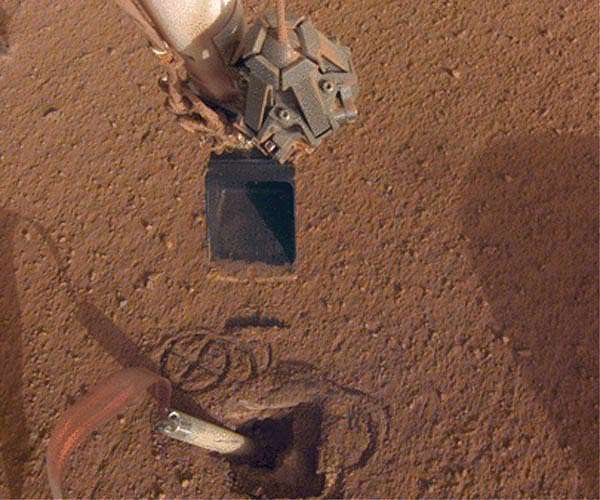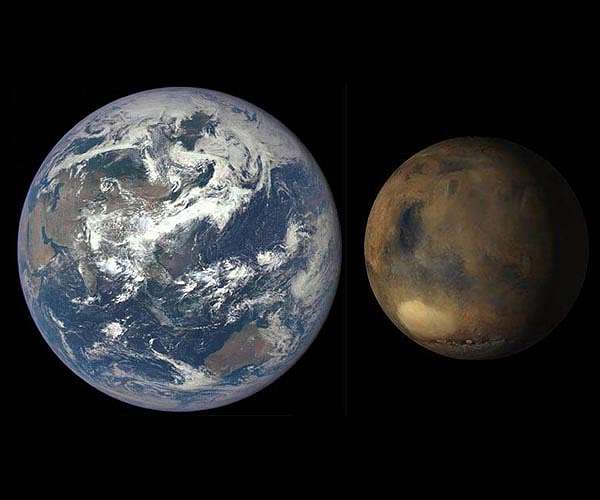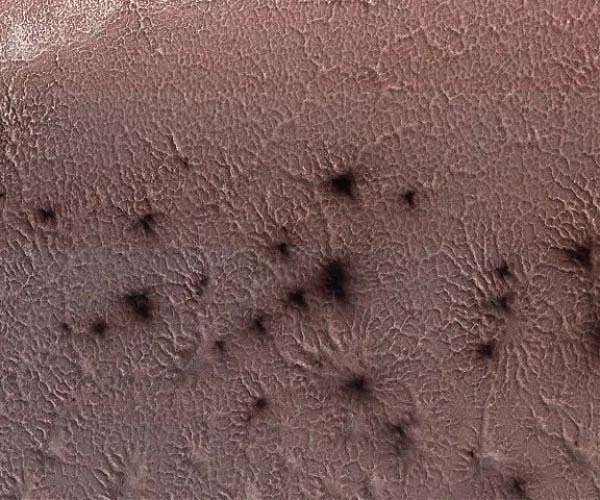Explanation found for encrusting of the Martian soil
by Robert Schreiber
Berlin, Germany (SPX) Oct 31, 2024
For four years, the Martian “Mole” HP3 experiment made notable contributions to planetary research on Mars. Named after the burrowing animal, the Heat Flow and Physical Properties Package (HP3), developed by the German Aerospace Center and European partners, was deployed on Mars in January 2019 as part of NASA’s InSight mission. Its goal was to dig up to five meters into the Martian soil and measure heat flow from the planet’s interior.
However, the Mole encountered unexpected resistance, unable to dig deeper than a shallow depth due to a hardened soil layer. Despite this, the temperature data it recorded at and just below the surface has led to surprising findings. Scientists discovered that the top 40 centimeters of Martian soil undergo temperature fluctuations that encourage the formation of a salt crust, or “duricrust,” which hardens the ground.
Over nearly four Earth years (or two Martian years), InSight collected temperature data from the surface at its landing site, providing crucial insight into the formation of duricrust on Mars.
The HP3 instrument, managed by DLR’s Institute for Planetary Research, struggled with Mars’ unusually hard and porous soil, which impeded further digging. “To get an idea of the mechanical properties of the soil, I like to compare it to floral foam, widely used in floristry for flower arrangements. It is a lightweight, highly porous material in which holes are created when plant stems are pressed into it,” said Tilman Spohn, HP3’s principal investigator at the DLR Institute.
Without enough friction between the Mole’s metal casing and the soil, it couldn’t absorb the recoil energy needed to dig deeper, and hammering attempts ended in early 2021. Still, the temperature readings gathered by the Mole are now published in ‘Geophysical Research Letters’, offering new insights.
Mars Soil Composition and Duricrust Development
Mars’ soil encrustation, down to about 20 centimeters, was an unexpected challenge for the Mole, which reached only 40 centimeters in depth. After concluding its hammering tests, HP3 was repurposed as a thermal probe to measure heat flow.
“Over the course of seven Martian days, we measured thermal conductivity and temperature fluctuations at short intervals,” explained Spohn. “Additionally, we continuously measured the highest and lowest daily temperatures over the second Martian year. The average temperature over the depth of the 40-centimetre-long thermal probe was minus 56 degrees Celsius (217.5 Kelvin).” These temperature records represent the first-ever Mars data tracking daily and seasonal thermal variations.
Temperature influences the Martian soil’s physical properties, including elasticity, thermal conductivity, and heat retention, all of which affect potential microbial life and other chemical processes.
“Temperature also has a strong influence on chemical reactions occurring in the soil, on the exchange with gas molecules in the atmosphere and therefore also on potential biological processes regarding possible microbial life on Mars,” Spohn noted. Such findings will prove critical in planning future human Mars missions.
Salt Crust Formation Through Seasonal Temperature Variation
Mars’ surface temperatures, varying by up to 130 degrees, diminish significantly at shallow depths, where fluctuations are reduced to only five to seven degrees daily and about 13 degrees seasonally. The upper Martian soil, acting as an insulator, minimizes temperature changes, 10 to 20 times more effectively than Earth’s soil.
In winter and spring, sufficient atmospheric moisture enables thin layers of salty liquid to form, promoting the creation of a hard duricrust layer that prevented the Mole from reaching deeper strata.
First Measurement of Martian Soil Density
Temperature data from the HP3 allowed scientists to calculate Mars soil’s thermal conductivity and diffusivity for the first time, leading to estimates of its density. The soil’s top 30 centimeters, including the duricrust, have a density similar to basaltic sand, commonly derived from iron and magnesium-rich volcanic rock on Earth. Beneath this crust, the soil resembles denser, coarse basalt.
Research Report:Mars Soil Temperature and Thermal Properties From InSight HP3 Data
Related Links
InSight at DLR
Mars News and Information at MarsDaily.com
Lunar Dreams and more



